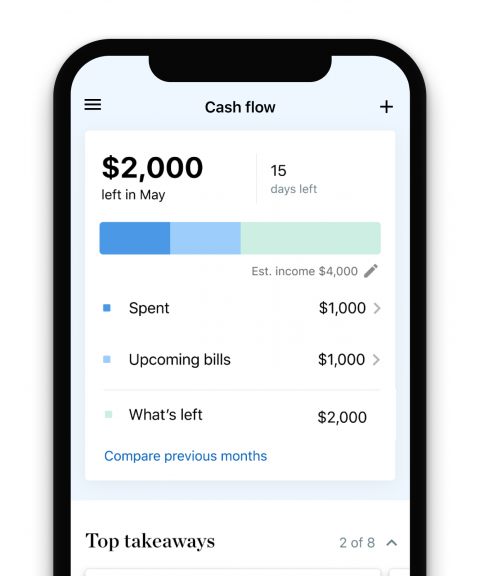How to Save Money Now (Before You Really Need It)

Many or all of the products featured here are from our partners who compensate us. This influences which products we write about and where and how the product appears on a page. However, this does not influence our evaluations. Our opinions are our own. Here is a list of our partners and here's how we make money.
You've been meaning to save more money. It's been on your mind for a while. But now — right now — feels like the time to get serious.
To save a big chunk of cash before you really need it.
When it comes to saving money, small changes can add up quickly. Here are some of the best ways to save money right away.
Interest rates are on the rise for savings accounts, thanks to the Federal Reserve’s actions this year.
22 ways to save money

1. Automate transfers
By setting up automatic transfers from your checking account to your savings account each month, the money will accumulate over time without any additional work on your part. This technique can be especially useful when your savings accounts are dedicated to specific goals, such as establishing an emergency fund, going on a vacation or building a down payment.
You can also let apps like Digit or Qapital do some of the work for you. After you sign up, they'll transfer small amounts from your checking account to a separate savings account for you. That way, you don’t have to spend time or energy thinking about making a transfer. You can learn more about apps that automate savings and decide if they’re a good fit for you.
2. Count your coins and bills
Another option is saving your change manually by setting it aside each night. After you have a sizable amount, you can deposit it directly into your savings and watch your account grow from there. In fact, when you want to watch your spending, it’s a good idea to use cash instead of credit cards because it can be harder to part with physical money. While this strategy doesn’t build savings overnight, it's a solid approach for slow-and-steady savings growth.
3. Prep for grocery shopping
A little work before you go to the grocery store can go a long way toward helping you save money on groceries. Check your pantry and make a shopping list to avoid impulse buying something you don't need. Learn how to get coupons and join loyalty programs to maximize your savings as you shop. In exchange for sharing your phone number or email address, your local store’s loyalty program might offer additional discounts.
If you use a cash-back credit card, you could earn extra cash back on grocery purchases. Some cards offer as much as 5% or 6% cash back, but you’ll want to be sure to pay off your bill each month to avoid paying interest and fees.
The app Flipp pulls in coupons from local stores when you enter your ZIP code. That way, you can shop sales without sorting through the newspaper. If you shop for groceries at a large retailer like Target, Amazon or Walmart, you can often find additional savings by downloading the store’s app.
4. Minimize restaurant spending
One of the easiest expenses to cut when you want to save more is restaurant meals, since eating out tends to be pricier than cooking at home. If you do still want to eat at restaurants, try to reduce the frequency and take advantage of credit cards that reward restaurant spending. You can also opt for appetizers or split an entree with your dining companion to save money when you eat out. Skipping drinks and dessert can help stretch your budget as well.
5. Get discounts on entertainment
You can take advantage of free days at museums and national parks to save on entertainment costs. Your local community might offer free concerts and other in-person or virtual events; check your local calendar before splurging on pricey tickets to private events. You can also ask about discounts for older adults, students, military members and more.
6. Map out major purchases
You can save by timing your purchases of appliances, furniture, cars, electronics and more according to annual sale periods. It’s also worth confirming a deal is actually a deal by tracking prices over time. You can let tools do this step for you; the Camelizer browser extension tracks prices on Amazon and can alert you to price drops. The Honey browser extension pulls in coupon codes and checks for lower prices elsewhere.
When you're shopping in person, make sure you get the best deal by using the ShopSavvy app. It lets you scan bar codes and alerts you to better prices elsewhere.
7. Restrict online shopping
You can make it more difficult to shop online in order to stop spending money on things you may not need. Instead of saving your billing information, opt to input your shipping address and credit card number each time you order. You’ll probably make fewer impulse purchases because of the extra work involved.

8. Delay purchases with the 30-day rule
One way to avoid overspending is to give yourself a cooling-off period between the time an item catches your eye and when you actually make the purchase. If you’re shopping online, consider putting the item in your shopping cart and then walking away until you’ve had more time to think it over. (In some cases, you might even get a coupon code when the retailer notices you abandoned the cart.) If 30 days seems like too long to wait, you can try shorter periods like a 24- or 48-hour delay.
9. Get creative with gifts
You can save money with affordable gift ideas, like herb gardens and books, or go the do-it-yourself route. Baking cookies, creating art or preparing someone dinner can demonstrate that you care just as much as making an expensive purchase, and perhaps even more so. You can also shower someone with the gift of your time by offering to take them to a local (free) museum or other event.
10. Lower your car costs
Refinancing your auto loan and taking advantage of lower interest rates could save you considerably over the life of your loan. Shopping around for car insurance regularly can also help you cut costs compared with simply letting your current policy auto-renew. You can cut ongoing car maintenance costs by driving less, removing heavy items from your trunk and avoiding unnecessary rapid acceleration.
11. Reduce your gas usage
You can't control prices at the pump, but you can do several things to cut your gas use and save money. Try using a gas app to pinch pennies when you do fill up.
12. Bundle cable and internet
You could lower your cable bill by as much as $40 per month by changing your cable package. And you could save more than $1,000 over two years by bundling your cable and internet service, depending on your carrier. Another option to consider is cutting cable or at least cutting some of your additional streaming services or premium subscriptions.
13. Switch your cell phone plan
Changing your plan is one way to save money on your cell phone bill, but it’s not the only way. Removing insurance from your plan could save you nearly $100 per year, per line. Signing up for autopay and paperless statements can save you an additional $5 to $10 per month, per line. We compared different cell phone plans to help you find the best match for you.
14. Reduce your electric bill
Big and small changes in your energy usage can help you save hundreds annually on your electric bill. Consider plugging any insulation leaks in your home, using smart power strips, swapping in more energy-efficient appliances and switching to a smart thermostat. Even incremental drops in your monthly electricity usage can add up to big savings over the long term.
15. Lower your student loan payments
Enrolling in income-driven repayment could lower your monthly payments to a manageable level since the amount you pay is tied to your earnings. Other options include refinancing, enrolling in autopay to trigger a discount, and making extra payments so you can unload the debt faster, which cuts the overall interest you’ll pay.
16. Cancel unnecessary subscriptions
Uncheck the auto-renew option on any subscriptions you aren’t using regularly, such as subscription boxes. You might even be paying for subscriptions you no longer use or need. Reviewing your credit card or bank statement carefully can help you flag any recurring expenses you can eliminate. And avoid signing up for free trials that require payment information, or at least make a note or set a calendar reminder to cancel before the free period ends.
17. Refinance your mortgage
Refinancing your mortgage can save you several hundred dollars each month if you’re able to snag a lower interest rate. Use our mortgage refinance calculator to find out how much you could save. While refinancing comes with some initial costs upfront, they can be recouped over time, once you start paying less each month.
18. Set savings goals
Set a specific but realistic goal. It may be “save $5,000 in an individual retirement account this year” or “pay off my credit card debt faster.” Use a savings goal calculator to see how much you’d have to save each month or year to reach your goal.
19. Track spending
Keep track of your monthly cash flow — your income minus your expenditures. This step will also make it easier to mark progress toward your savings goal. Try a budget app that tracks your spending. (NerdWallet has a free app that does just that.) Or you can follow these five steps to help track your monthly expenses.
20. Pay off high-interest debt
Debt payments can be a huge burden on your overall budget. If you can pay off high-interest debt more quickly through extra payments using the snowball or avalanche methods, you’ll save on total interest paid and free yourself sooner from that burden. Then, start putting the money into savings instead.
21. Keep savings in a high-yield savings account
As you work toward your financial goals, make sure to put your accumulating funds in a high-yield online savings account to maximize your money. Some of the best online accounts pay interest rates that are higher than the ones at large traditional banks.
22. Create a 50/30/20 budget
One smart way to manage your money — and hopefully hold on to more of it — is to follow a budget, which means setting priorities for your spending.
At NerdWallet, we recommend the 50/30/20 budget for money management. This approach means devoting 50% of your after-tax income to necessities, 30% to wants and 20% to savings and any debt payments. If one of your allocations exceeds these percentages, you can make some adjustments elsewhere.
» LEARN: How to save money in Canada

